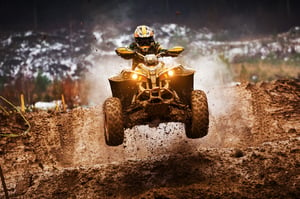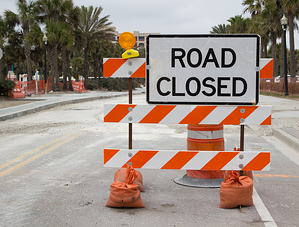Written on Feb 2, 2017 2:02:00 PM
9 Reasons ATV Accidents Happen in Florida
Topics: auto accident, personal injury, atv accident
Going off-road on an ATV is a pretty popular pastime for many Floridians (and vacationers). However, as fun as it is to hit the dirt trail and watch the mud fly, riding an ATV can be very dangerous.
 ATV accidents happen all the time. According to the U.S. Consumer Product Safety Commission (CPSC), in 2012 alone, there were 100,000 injuries involving ATVs in the USA. Worse yet, Florida ranks among the top 10 states for ATV fatalities.
ATV accidents happen all the time. According to the U.S. Consumer Product Safety Commission (CPSC), in 2012 alone, there were 100,000 injuries involving ATVs in the USA. Worse yet, Florida ranks among the top 10 states for ATV fatalities.
Why do so many ATV accidents happen in Florida?
Top Causes for ATV Accidents in FL
A few reasons may include:
1: Reckless Driving
The practice of “goon riding” or driving dangerously as a stunt is a major contributing factor for ATV crashes. Things like popping wheelies, speeding too fast, and taking your hands off the steering to strike poses can easily lead to a loss of control.
When riding an ATV, it’s important to focus on maintaining control of the vehicle rather than showing off tricks.
2: Riding Under the Influence
Just because you’re sticking to the dirt paths doesn’t mean that it’s okay to drink and ride. Alcohol and other drugs can severely impact your reaction time and judgement, making what would be a perfectly safe travel speed and path far deadlier than normal.
Alcohol is a depressant, and, as noted by the CDC, a blood alcohol concentration (BAC) of as little as 0.05% (or about 3 alcoholic drinks) can cause:
- Reduced coordination
- Reduced ability to track moving objects
- Difficulty steering
- Reduced response to emergency driving situations
These impairments significantly increase the risk of ATV crashes, especially in foliage or rough terrain.
3: Riding on Paved Roads Meant for Cars & Trucks
 While ATVs are vehicles with motors, they are definitely not safe for use on the road. ATVs cannot reach the same speeds that cars maintain, and lack many of the protective measures cars give their drivers/passengers.
While ATVs are vehicles with motors, they are definitely not safe for use on the road. ATVs cannot reach the same speeds that cars maintain, and lack many of the protective measures cars give their drivers/passengers.
It’s very easy for a car or truck to not see an ATV in the other lane and accidentally bump into them during a lane change.
As noted by CPSC data, roughly 33% of all ATV accidents nationwide occur on paved roads, while only 5% occurred on a “desert, sand dunes, beach, or off-highway vehicle park.” In other words, you’re over 6 times more likely to get into an accident on a paved road than riding in the vehicle park.
4: Riding Off the Trail
ATV vehicle parks and trails are specifically prepared and maintained to provide a safe riding environment for quad riders. Going off these paths into the woods surrounding them brings with it a drastically increased risk of accidental injury.
Off the trail, it’s very easy to hit a tree root, a large rock, or bit of swampy soil that can cause you to lose control of your quad.
5: Lack of Training or Experience with ATVs
First-time riders are especially susceptible to getting injured while riding ATVs. Even if they have previous experience with motorcycles, the handling characteristics of an ATV can still surprise a first-time rider.
This is why organizations such as the CPSC urge riders to get training from a qualified instructor before riding on their own.
6: Underage Riders On Adult-Sized ATVs
A full-sized ATV can weigh up to 600 pounds and travel at speeds of 60-70 mph (depending on the model). Handling these vehicles on a bumpy dirt path takes a fair amount of physical strength and coordination—not to mention experience.
Underage riders on adult-sized ATVs are put in danger because they may not have the ability to properly control these vehicles—their arms or legs might not comfortably reach the controls and they may have a harder time maintaining balance during turns.
Children under the age of 16 need to ride ATVs designed for smaller, less experienced riders.
7: Too Many People Riding the Same ATV
Most ATVs are designed to accommodate only one rider at a time. Adding a second rider to these ATVs can overload their shocks and make it easier for the driver to lose balance on a bump or turn.
There are some ATVs designed for two riders. If you’re going to ride double, it’s best to use an ATV that’s designed for the job. However, even with a 2-rider vehicle, it’s best to be careful.
8: Lack of ATV Maintenance
ATVs see some pretty harsh use for the few minutes or hours of use they get in a day. Every bump, mud spray, hard stop, and hard acceleration contributes to the wear and tear of vital vehicle components.
Because of the intensity of some of these impacts and their frequency, ATV tires, shocks, and other components can be prone to failure if they aren’t frequently checked and maintained. Busted shocks can cause a loss of control resulting in a crash or the throwing of a rider off of the ATV.
Be sure to inspect your ATV’s condition before putting it to use.
9: Poor ATV Path Maintenance
If ATV trails aren’t properly maintained, they can become dangerous to ride on. A poorly-maintained path may have potholes, debris, and other problems that make it tougher to maintain control.
As a precaution, before riding your ATV at a higher speed, try to check the general condition of the trail. Keep an eye out for hazards like broken ATV parts, fallen tree branches, or pits/potholes in the trail.
These are just a few of the top causes of ATV accidents in Florida. Hopefully, knowing what these risks are will help you be prepared if and when you decide to ride an ATV.
For more information about ATV safety, check out our “Avoiding ATV Accidents” post!

